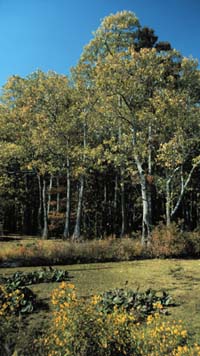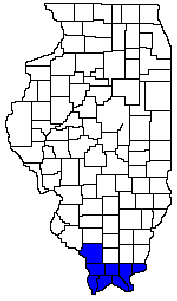 |
| Tupelo
Gum (Nyssa aquatica)
Distribution
Map to Right |

Tupelo gum, also referred to as water tupelo, swamp tupelo, or cotton gum, grows to between 80 - 100 feet tall, with a trunk diameter of up to 4 feet. Tupelo gum is a graceful tree. The base of the trunk is swollen or flared outward, and the trunk tapers upward from the base. The buttressed trunk provides stability in the moist soils and peats of swamps and lowland forests. The crown is flattened and spreading, with numerous branchlets.
Tupelo gum grows in swamps and floodplains in the south, where the soils are at least periodically flooded and the roots are under water. It occurs along the coastal southeastern U.S. from southeastern Virginia to Georgia, west across northwestern Florida along the Gulf of Mexico to southeastern Texas. It extends up the Mississippi in floodplains and swamps. It reaches its northern limit in the extreme southern tip of Illinois, where it occurs commonly with Cypress in swamps.
Interesting
Facts
Tupelo gum is a long-lived tree and some of the best examples of large, old growth trees occur in the Cache River area in Illinois on land once owned by the Main brothers (read about it in Conservation section - Early Efforts). This area is now an Illinois Natural Area. The cypress and tupelo gum swamps in the Cache River Nature Preserve contain trees that are 1000 years old.
Whereas tupelo gum grows best on sites that are flooded through a portion of the year, seeds will only germinate when the water recedes, which is usually by mid or late summer. After the seeds germinate, the seedlings develop best in saturated soils that are not stagnant, but covered by shallow water. They grow best in full sunlight, and mature trees are intolerant of shade.
Mature tupelo gum trees survive flooding better than other species because of special adaptations in the roots to the oxygen deprivation arising from the soil saturation.
- They are shallow (closer to the surface and a source of oxygen)
- They have abundant intercellular spaces in the cortex (more avenues for oxygen transport to the roots from other parts of the plant).
Identifying Features
Bark
Tupelo gum bark is dark brown or dark gray. It is finely fissured, thin and scaly, and when damaged, the tree is susceptible to fungal attack.
Twigs
The twigs are stout and reddish brown.
Buds
The buds are very small, rounded, and smooth.
Leaves
The leaves are alternate, simple, and somewhat ovate, tapering to a point at the tip. They are usually rounded at the base and are quite large; up to 8 inches long and half again as broad. Most have smooth edges or edges with only a few coarse teeth. They are dark green and smooth on the surface and paler with fine hairs beneath. The thick leafstalks are hairy and are 1 - 3 inches long.
Flowers
Tupelo gum is dioecious, having male (staminate) and female (pistillate) flowers borne separately on separate trees. Flowers appear in spring at leafout. The female flowers appear as single flowers on long stalks hanging from the junction between the leafstalk and twig (leaf axils). The male flowers appear as spherical clusters.
Fruits
The oblong, fleshy fruits ripen in September and are purple and up to an inch long. They enclose a single seed and are bitter.
Uses
Tupelo
gum is a good ornamental on wet sites. Wood duck, other birds, squirrels,
raccoon, and deer eat the fruits and the flowers are the source of tupelo
honey. The wood is light weight and soft, and is used for broom handles,
floors, and pulp. The base (butt) of the tree contains wood that is much
lighter than that further up the trunk and it is the basal wood that makes
better pulp products.